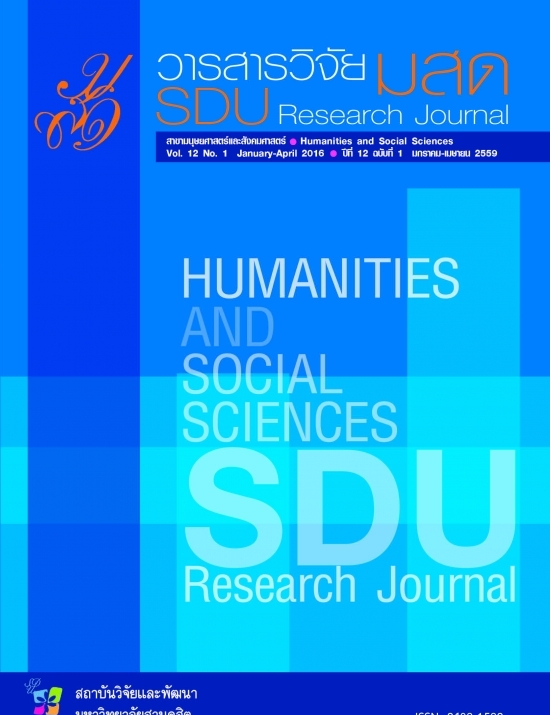การพัฒนาแบบวัดคุณลักษณะการอยู่อย่างพอเพียงสำหรับนักเรียนชั้นมัธยมศึกษาตอนต้น ตามหลักสูตรแกนกลางการศึกษาขั้นพื้นฐาน พุทธศักราช 2551
Keywords:
Sufficient, Moderation, Reasonableness, Self – immunityAbstract
The purposes of this study were: 1) to study the aspects of sufficiency,
2) to construct the Sufficient Life Scale (SLS), 3) to verify the qualities of the SLS, and
4) to create norms and a manual of the SLS for the lower secondary students. The sample
was 1,866 lower secondary students in the academic year 2557 of schools under the
Secondary Educational Service Area Office 18 which were obtained by employing a
multi-stage random technique. The situational stems and four level choices of morals
were included in three sub-scales: moderation scale, reasonableness scale, and
self-immunity scale. Each choice of SLS was scored one for the lowest and four for the
highest level of Sufficiency. The qualities of SLS were examined in terms of content
validity, concurrent validity, construct validity, and internal consistency index for reliability.
The results showed that IOC ranged from 0.60 to 1.00. The t-test results showed high
discrimination power of each question (t-values ranged from 2.27 to 10.37 at 0.05 and 0.01
significance levels). The internal consistency of scales by using the Cronbach’s alpha
coefficient were 0.73, 0.89 and 0.85, respectively. The indices of multidimensional scaling
(MDS) analysis were the stress index at 0.228 and RSQ at 0.641 that showed optimal
dimensions of SLS. The T-scores of SLS ranged from 19 to 83.
References
Bangkok: Development Studies. (in Thai)
Hu, L. & Bentler, P.M. (1999). Cutoff Criteria for Fit Indices in Covariance Structure Analysis:
Conventional Criteria Versus new Alternatives. Structural Equation Modeling, 6,
1-55.
Kanjanawasi, S. (2001). The Original Testing Theory. 4th ed. Bangkok: Printing Chulalongkorn
University. (in Thai)
Ketsing, W. (1987). Statistics for Social Science Research. Bangkok: Wathanapanich. (in Thai)
Kline, R.B. (1998). Principles and Practice of Structural Equation Modeling. 3rd ed.
New York: Guilford Press.
Office of the National Economic and Social Development Board. (2008). From the
Philosophy ... Into Practice. Bangkok: Pechrung Printing. (in Thai)
Patricia, C. (1977). The Education Standard Testing Manual for Mathayom 3. Bangkok:
Teachers Council. (in Thai)
Saiyos, L. & Saiyos, A. (1996). Technical Indicators to Measure Learning. 4th ed. Bangkok:
Suwiriyasan. (in Thai)
_______. (2000). Measuring the Reputation. Bangkok: Suwiriyasan. (in Thai)
Srisaard, B. (1997). The Research and Evaluation. Bangkok: Suwiriyasan. (in Thai)
Thaweerat, P. (1997). How Behavioral and Social Sciences Research. Bangkok:
Srinakharinwirot University. (in Thai)
The Ministry of Education. (2002). The Research to Develop Learning Sneezing Basic
Education Curriculum. Bangkok: ETO. (in Thai)
_______. (2007). Strategy-driven Philosophy to Education (2550 - 2554). Bangkok: A Central
Coordination Center Operations due to the Project, MOE works, Office of Special
Affairs, The Education Office of the Action. (in Thai)
_______. (2008). Core Curriculum for Basic Education Curriculum 2551. Bangkok: Printing
teachers lat. (in Thai)
Tirakanon, S. (2003). Methods in Social Science Research: Guidelines into Practice.
Bangkok: Printing Chulalongkorn University. (in Thai)
Yamane, T. (1973). Statistic: An Introductory Analysis. 3rd ed. New York : Harper and Row.
Downloads
Published
How to Cite
Issue
Section
License
Copyright (c) 2019 Journal of Multidisciplinary in Social Sciences

This work is licensed under a Creative Commons Attribution-NonCommercial-NoDerivatives 4.0 International License.








